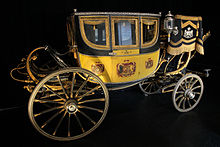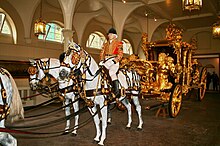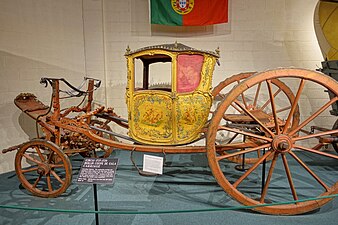State coach


A state coach, also known as a gala coach, is a highly decorative ceremonial coach used in Europe by a monarch or head of state on state occasions. A four-wheeled vehicle for four passengers, it may be drawn at a walk by six or more horses with postilions, or be driven by two or more horses. The term is also used to indicate a formal town coach used by nobility and the wealthy for formal occasions, drawn by a pair of matching horses.[1]: 154 [2]: 101, 102
A state chariot, also called a gala chariot or dress chariot, is an elaborately decorated four-wheeled vehicle for two passengers for ceremonial occasions; often the front panel is replaced by a glass panel or windscreen.[1]: 44, 154 [2]: 85 The word chariot was used in England, and coupé in France.[3]: 95
Overview
[edit]The first state coach was built in the mid-1500s by Walter Rippon for the State Opening of Parliament,[4]: 72 [5]: 20 and most had been built by 1840.[2]: 102 State coaches are still used for royal weddings and other state ceremonial events.[4]
State coaches were built by the best coachbuilders with excellent craftsmanship and the finest finishes. Most state coaches have large glass windows so that their passengers can be seen by spectators. The interiors are trimmed in silks and the exteriors decorated with elaborate paintings, figures, coats of arms, gilt-work, and hammercloths. The coachman and footmen wear state livery and the horses are harnessed with ornate state harness.[4]: 255–6

The coachmen, footmen, and postilions on state coaches wore ornate livery to match the grandeur of the coaches themselves. ... dressed in appropriately ornate livery coats, richly embellished with gold cords and strappings, worn with silk knee breeches, silk stockings, buckled shoes, and a cocked hat.
— Thomas Ryder, Fashion on Wheels [3]: 94
Early state coaches in England were drawn by cream-colored horses of Hanoverian blood. In the early 1920s they were replaced by black horses. Now, teams of greys are used for the Sovereign, and bay horses are used for other passengers. Horses may be driven, or ridden by postilion.[4]: 97, 255–6
Another type of state coach is the cardinal's coach, which was painted red and used by cardinals.[1]: 48 [2]: 97
List of state coaches
[edit]| Image | Name | Built[a] | State | Location | Notes |
|---|---|---|---|---|---|
 | Speaker's State Coach | 1698 | United Kingdom | Palace of Westminster London | Built for William III |
 | Imperial Coach | 1735 | Austria | Imperial Carriage Museum Vienna | Built for Charles VI |
 | Lord Mayor of London's State Coach | 1757 | United Kingdom | Museum of London London | Built by Joseph Berry [5]: 145 |
 | Gold State Coach | 1762 | United Kingdom | Royal Mews London | Built for George III [2]: 100 |
 | Glass Coach | 1826 | Netherlands | Royal Stables The Hague | Built for William I |
 | Scottish State Coach | 1830 | United Kingdom | Royal Mews London | Built for Prince Adolphus |
 | Golden Coupé | 1840 | Denmark | Royal Mews and Carriage Museum, Christiansborg Palace Copenhagen | Built for Christian VIII |
 | Irish State Coach | 1851 | United Kingdom | Royal Mews London | Built by Thomas Hutton, and later purchased by Queen Victoria. Replicated by Barkers in 1911 when it was destroyed by fire at their shop [5]: 123 |
 | Queen Alexandra's State Coach | 1865 | United Kingdom | Royal Mews London | Built as a town coach, later converted to a state coach for Queen Alexandra |
 | Glass Coach | 1881 | United Kingdom | Royal Mews London | Purchased by the Crown for George V coronation in 1911 |
 | Cotillion Coach | 1888 | Denmark | Royal Mews and Carriage Museum, Christiansborg Palace Copenhagen | Miniature coach for Christian IX |
 | Golden Coach | 1898 | Netherlands | Royal Stables The Hague | Built for Queen Wilhelmina |
 | State Landau | 1902 | United Kingdom | Royal Mews London | Built by Hooper for Edward VII; drawn by 6 grey horses with three postilion riders [5]: 122 |
 | Australian State Coach | 1988 | United Kingdom | Royal Mews London | Built for Elizabeth II |
 | Diamond Jubilee State Coach | 2010 | United Kingdom | Royal Mews London | Built for Elizabeth II |
Gallery
[edit]- A sampling of the variety of state coaches and chariots
- 1729 gala coupé, Royal House of Portugal
Notes
[edit]- ^ Dates may be approximate, since some of the coaches took many years to complete, and others have scant records
References
[edit]- ^ a b c Smith, D.J.M. (1988). A Dictionary of Horse Drawn Vehicles. J. A. Allen & Co. Ltd. ISBN 0851314686. OL 11597864M.
- ^ a b c d e Berkebile, Donald H. (1978). Carriage Terminology: An Historical Dictionary. Smithsonian Institution Scholarly Press. ISBN 9781935623434. OL 33342342M.
- ^ a b c Mackay-Smith, Alexander; Druesedow, Jean R.; Ryder, Thomas (1984). Man and the Horse: An Illustrated History of Equestrian Apparel. Metropolitan Museum of Art. ISBN 0870994115. OL 2859979M.
- ^ a b c d Walrond, Sallie (1979). The Encyclopaedia of Driving. Country Life Books. ISBN 0600331822. OL 4175648M.
- ^ a b c d Nockolds, Harold, ed. (1977). The Coachmakers: A History of the Worshipful Company of Coachmakers and Coach Harness Makers, 1677-1977. JA Allen. ISBN 0851312705. OL 26258137M.
- ^ "Grand Gala Berlin". Vatican Museum. Retrieved 29 July 2024.
- ^ "Berlinda da Casa Real" [Royal House Berlin]. National Coach Museum (Portugal) (in Portuguese). Retrieved 29 July 2024.
Further reading
[edit]- Damase, Jacques (1968). Carriages. G. P. Putnam's Sons. OL 5604950M.


 French
French Deutsch
Deutsch![The Papal Grand Gala Berlin, commissioned by Pope Leo XII (1826) [6]](http://upload.wikimedia.org/wikipedia/commons/thumb/b/b2/Grand_Gala_Berlin.jpg/300px-Grand_Gala_Berlin.jpg)
![Dress coach of Ludwig II of Bavaria (1870) [3]: 93–4](http://upload.wikimedia.org/wikipedia/commons/thumb/a/a2/M%C3%BCnchen_2012_%28507%29.jpg/340px-M%C3%BCnchen_2012_%28507%29.jpg)
![18th century Berlin from France [7]](http://upload.wikimedia.org/wikipedia/commons/thumb/9/97/Berlinda_da_Casa_Real_-_Museu_Nacional_dos_Coches_-_Lisboa_-_Portugal_%2851032221001%29.jpg/300px-Berlinda_da_Casa_Real_-_Museu_Nacional_dos_Coches_-_Lisboa_-_Portugal_%2851032221001%29.jpg)
